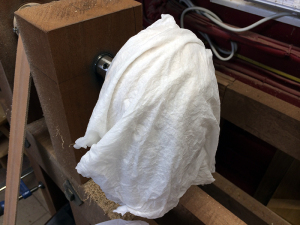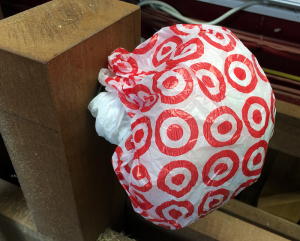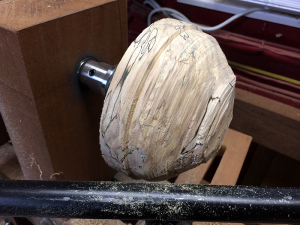Preventing Your Bowl Blanks from Cracking Up
Turning a bowl from green wood creates additional pressure on the woodworker that has nothing to do with screwing up the work with a tool catch. A hunk of green wood that has been split and/or sawn out into a bowl like object is shedding moisture fast and it will start to crack up right before your eyes. This is why most bowl turners state that once you get started you better have the time to finish. As the bowl is shaped and especially as it is hollowed a lot of the tension caused by outer layers drying faster than the inner layers goes away. The wood will still move but now it is free to and depending on the thickness of the walls, it can move homogeneously.
Now let’s get back to reality. These days I rarely have more than a few hours free in the shop at any one time. Add to that my slower pace of work in general, but especially with my foot powered lathes. It is less an rpm issue but more a torque issue with larger items like bowls. If I take too heavy a cut I will cause my belt to slip so I go slow and light on the tool. I have thought about improvements to increase the torque but frankly I like this safety measure that way it is. Most of the work I do at the lathe is spindle turning and I rarely get belt slippage for 2-3″ diameter pieces so I’m less inclined to mess with the lathe. But this means that when you combine my relative inexperience with bowl turning, lack of continuous time, and a need to turn slower due to the lathe, I rarely will get a bowl done in one session. Don’t forget that I’m splitting and chopping to shape with an axe too which can add 30 minutes to the process.
 Am I just doomed to bowl blanks that crack and split on me midway through a project? Heck no! I take a tip from clay sculptors and insulate my blank. When I’m finished turning for the day I will drape a damp paper towel over the bowl taking care to keep it away from any metal fixtures that might rust. One benefit of a wood bodied lathe is that there are very few ferrous surfaces. This paper towel is wet and wrung out vigorously. I don’t want it dripping wet as that will add moisture. The goal is just to maintain the moisture levels of the outer layers of the blank.
Am I just doomed to bowl blanks that crack and split on me midway through a project? Heck no! I take a tip from clay sculptors and insulate my blank. When I’m finished turning for the day I will drape a damp paper towel over the bowl taking care to keep it away from any metal fixtures that might rust. One benefit of a wood bodied lathe is that there are very few ferrous surfaces. This paper towel is wet and wrung out vigorously. I don’t want it dripping wet as that will add moisture. The goal is just to maintain the moisture levels of the outer layers of the blank.
 Now I wrap the whole thing in a plastic shopping bag. Any will do, but I find that Target bags add that pop of color that really dresses up the entire shop.
Now I wrap the whole thing in a plastic shopping bag. Any will do, but I find that Target bags add that pop of color that really dresses up the entire shop.
I have left a mid process bowl blank on the lathe as long as 6 days and not a single crack showed up. So I think this process does the trick.
Don’t forget to paint the ends of your waiting log stock with something like Anchorseal however or you will run out of logs to split into bowl blanks in the first place and instead get some pretty firewood or spoon blanks.



